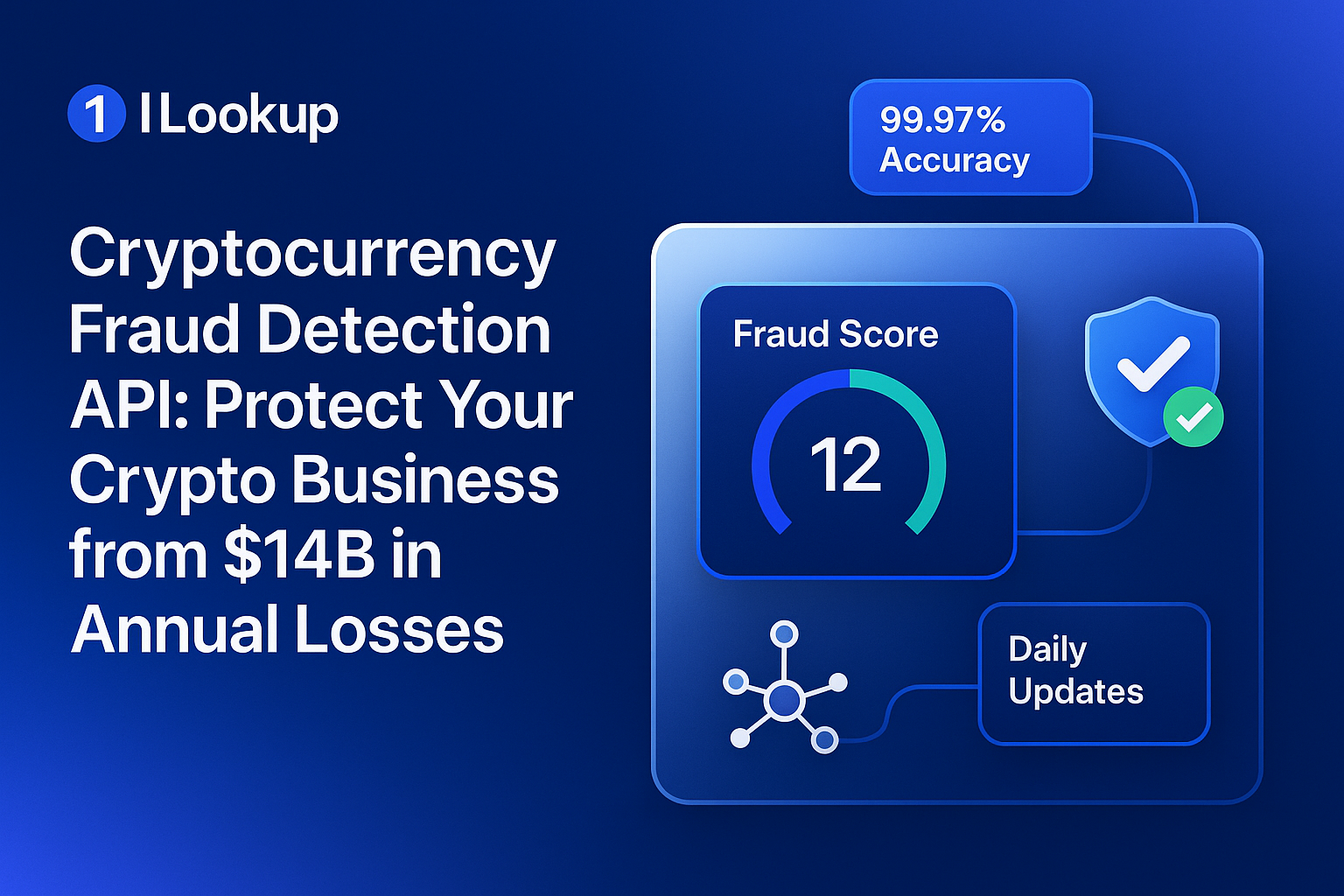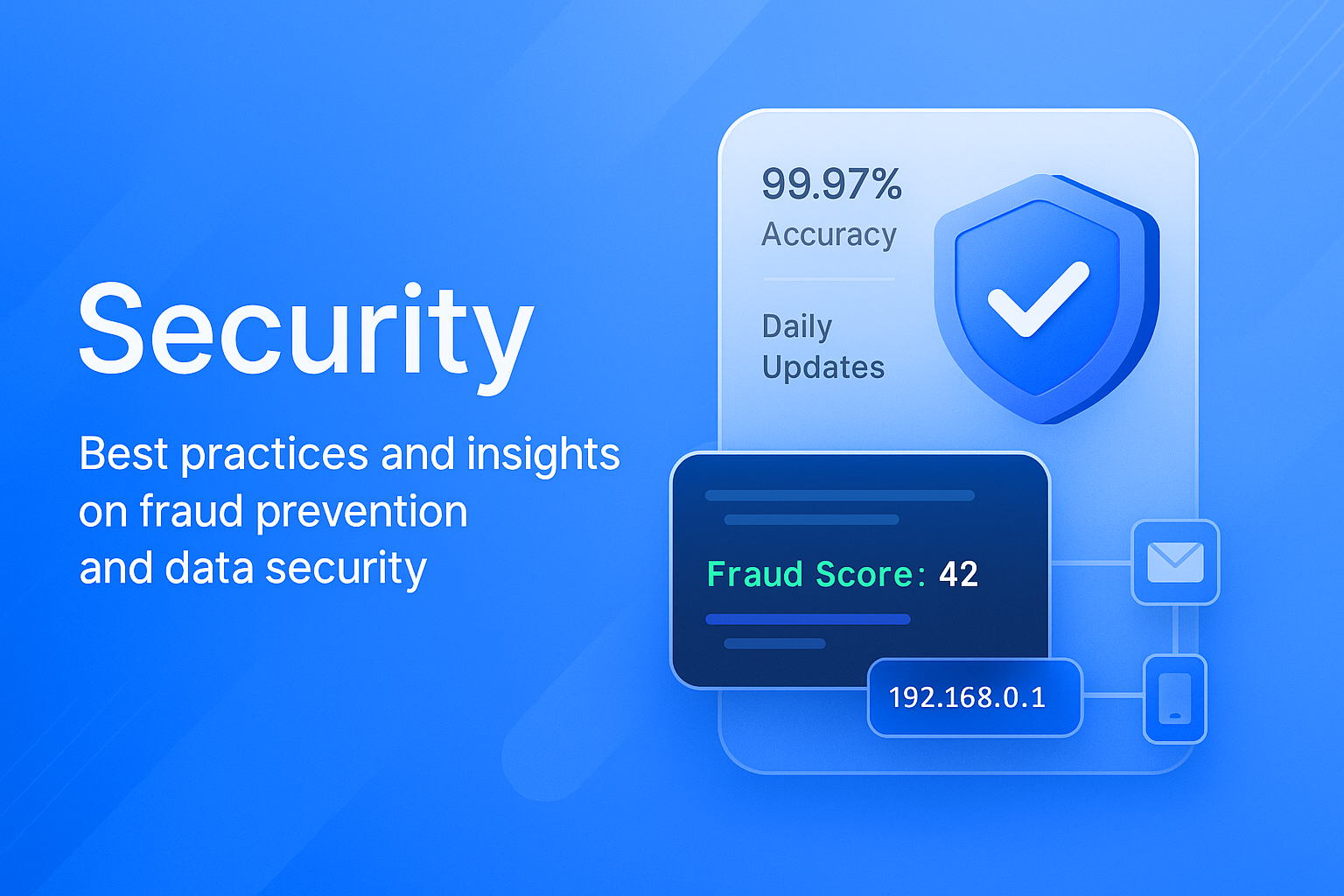Learn how crypto fraud detection APIs save exchanges and DeFi platforms from sophisticated scams. Stop fake KYC, SIM swaps, and wallet manipulation attacks.
Robby Frank
Founder & CEO

Cryptocurrency Fraud Detection API: Protect Your Crypto Business from $14B in Annual Losses
When CryptoPay's exchange was hit with $2.3 million in fraudulent withdrawals over a weekend, the attack traced back to 1,247 fake accounts created with synthetic identities and manipulated phone numbers. Their basic KYC validation had approved accounts using legitimate-looking phone numbers that were actually part of a sophisticated fraud operation.
Cryptocurrency fraud costs the industry $14 billion annually, with 73% of incidents involving identity manipulation and fake verification data. Traditional fraud detection tools weren't built for crypto's unique challenges - instant global transactions, pseudonymous users, and regulatory complexity across jurisdictions.
Here's how cryptocurrency fraud detection APIs specifically designed for digital assets can protect your platform from the sophisticated attacks targeting crypto businesses today.
The Unique Fraud Landscape in Cryptocurrency
Crypto fraud differs dramatically from traditional financial fraud due to the industry's fundamental characteristics:
Why Traditional Fraud Detection Fails in Crypto
Instant Global Transactions: Traditional banking fraud detection has hours or days to analyze patterns. Crypto transactions are irreversible within minutes across global borders.
Pseudonymous Nature: Users expect privacy, making traditional identity verification challenging while still complying with AML/KYC requirements.
Regulatory Complexity: Different rules across jurisdictions create compliance gaps that fraudsters exploit systematically.
High-Value Targets: Average crypto fraud incidents are 340% larger than traditional financial fraud due to concentrated wealth and irreversible transactions.
2024 Crypto Fraud Statistics
- $14 billion total losses across all cryptocurrency platforms
- $2.8 million average loss per successful exchange attack
- 67% of DeFi exploits involve social engineering and identity fraud
- 89% of crypto fraud uses manipulated phone numbers for initial account creation
- 23 minutes average time from account creation to first fraudulent transaction
Types of Crypto-Specific Fraud Attacks
Synthetic Identity KYC Bypass
Attack method: Fraudsters create fake identities using real phone numbers combined with stolen or fabricated documents to pass KYC verification.
Crypto-specific tactics:
- Using phone numbers from countries with weak identity verification
- Exploiting regulatory differences between jurisdictions
- Creating multiple accounts across different exchanges with the same phone number
- Timing attacks during high-volume trading periods when manual reviews are rushed
Detection signals:
- Phone numbers issued within 30 days in high-risk countries
- Same phone number used across multiple exchanges
- Geographic inconsistencies between phone location and stated residence
- Phone numbers associated with document mills or fake ID services
SIM Swap Account Takeover
Attack method: Fraudsters hijack legitimate phone numbers to bypass 2FA and gain control of high-value crypto accounts.
Crypto targeting factors:
- Higher payoff: Crypto wallets often contain substantial value
- Irreversible transactions: Once funds are moved, recovery is impossible
- Global mobility: Stolen crypto can be laundered across multiple chains instantly
- Limited recourse: No traditional banking protections or chargeback mechanisms
Advanced detection indicators:
- Recent carrier porting activity (especially international ports)
- Sudden changes in login location combined with phone verification
- Multiple failed 2FA attempts followed by successful phone-based reset
- Unusual transaction patterns immediately after phone verification events
Cross-Chain Money Laundering
Attack method: Using multiple phone numbers to create accounts on various exchanges and DeFi platforms for sophisticated money laundering operations.
Detection patterns:
- Phone numbers creating accounts on multiple exchanges within short timeframes
- Systematic use of phone numbers from privacy-focused carriers
- Coordinated account creation patterns across related phone numbers
- Phone numbers associated with mixing services or privacy coin transactions
Building Crypto-Specific Fraud Detection
Layer 1: Enhanced Phone Intelligence for Crypto
Standard phone validation plus crypto-specific signals:
- Regulatory jurisdiction mapping: Phone number location vs. platform compliance requirements
- Exchange cross-reference: Check phone usage across known crypto platforms
- High-risk carrier identification: Carriers commonly used in crypto fraud
- Privacy service detection: Phone numbers from anonymous or privacy-focused services
Crypto fraud risk scoring:
def calculate_crypto_risk_score(phone_data):
base_score = standard_phone_validation(phone_data['phone'])
crypto_modifiers = {
'privacy_carrier': +25, # Anonymous phone services
'high_risk_jurisdiction': +20, # Fraud haven countries
'exchange_sharing': +15, # Same number on multiple exchanges
'new_activation': +30, # Recently activated numbers
'tor_association': +35, # Phone linked to Tor usage
}
return min(base_score + sum(applicable_modifiers), 100)
Layer 2: Cross-Platform Correlation
Multi-exchange intelligence:
- Shared phone usage: Identify numbers used across multiple crypto platforms
- Velocity patterns: Rapid account creation across exchanges
- Transaction timing: Coordinated activity patterns
- Geographic anomalies: Impossible travel between transaction locations
DeFi protocol integration:
- Wallet association: Link phone numbers to on-chain wallet addresses
- Smart contract interaction patterns: Unusual protocol usage
- Liquidity pool manipulation: Phone numbers associated with rug pulls
- Token launch fraud: Numbers connected to honeypot tokens
Layer 3: Blockchain Intelligence Integration
On-chain analysis correlation:
- Address clustering: Link phone numbers to wallet address clusters
- Transaction pattern analysis: Identify money laundering patterns
- Exchange flow tracking: Monitor deposit/withdrawal patterns
- Smart contract risk assessment: Flag interactions with known scam contracts
Industry-Specific Implementation Strategies
Centralized Exchanges (CEX)
High-risk touchpoints:
- Account registration and KYC verification
- High-value withdrawal requests
- P2P trading platform access
- Margin trading account approval
Implementation approach:
class CryptoExchangeFraudAPI:
def assess_registration_risk(self, user_data):
phone_risk = self.analyze_phone_number(user_data['phone'])
kyc_risk = self.cross_reference_kyc_data(user_data['documents'])
behavioral_risk = self.analyze_signup_behavior(user_data['session'])
combined_risk = self.weight_crypto_specific_factors({
'phone_analysis': phone_risk,
'document_verification': kyc_risk,
'behavioral_patterns': behavioral_risk,
'jurisdiction_compliance': self.check_regulatory_requirements(user_data)
})
return {
'risk_score': combined_risk,
'recommended_action': self.determine_kyc_level(combined_risk),
'monitoring_flags': self.set_ongoing_monitoring(combined_risk)
}
DeFi Platforms
Unique fraud vectors:
- Airdrop gaming: Multiple accounts for token farming
- Governance manipulation: Fake accounts for voting power
- Liquidity pool attacks: Coordinated account creation for market manipulation
- Smart contract exploitation: Phone numbers associated with MEV bots and flash loan attacks
Detection strategy:
- Wallet clustering: Group related addresses by phone verification patterns
- Transaction timing analysis: Identify coordinated trading activity
- Gas optimization patterns: Detect sophisticated technical users vs. retail
- Multi-protocol correlation: Track activity across different DeFi platforms
Crypto Payment Processors
Fraud patterns:
- Merchant account fraud: Fake businesses using stolen identities
- Chargeback arbitrage: Using stolen cards to buy crypto
- Cross-border compliance: Exploiting regulatory gaps
- High-risk merchant onboarding: Shell companies for money laundering
ROI Analysis for Crypto Fraud Detection

Cost of Crypto Fraud vs. Prevention
Average crypto fraud incident costs:
- Direct losses: $2.8 million average per exchange attack
- Regulatory fines: $500K-$5M for compliance failures
- Legal costs: $200K-$800K for incident response
- Reputation damage: 34% customer churn post-incident
- Operational impact: 67 days average recovery time
Fraud detection investment:
- API costs: $0.02-$0.08 per phone verification (crypto-enhanced)
- Implementation: $25K-$100K initial setup
- Ongoing maintenance: $5K-$20K monthly
- Staff training: $10K-$25K initial
Sample ROI Calculation
Mid-size crypto exchange (50K monthly users):
- Detection cost: 50K × $0.05 = $2,500/month
- Fraud prevented: 2-3 major incidents annually = $5.6M-$8.4M saved
- Compliance cost avoidance: $1M+ in potential fines
- Customer retention value: $890K in prevented churn
- Annual ROI: 22,300-28,900%
Advanced Crypto Fraud Detection Features
Real-Time Blockchain Monitoring
Integration with on-chain data:
- Address screening: Instant checks against known scam addresses
- Transaction pattern analysis: ML models trained on crypto-specific fraud
- Cross-chain tracking: Follow funds across different blockchains
- Smart contract risk assessment: Automated analysis of contract interactions
Regulatory Compliance Automation
Multi-jurisdiction compliance:
- FATF Travel Rule: Automated compliance for cross-border transactions
- Sanctions screening: Real-time OFAC and global sanctions checks
- Reporting automation: Suspicious Activity Report (SAR) generation
- Audit trail maintenance: Immutable compliance records
AI-Powered Pattern Recognition
Machine learning models trained on crypto-specific data:
- Behavioral analysis: User interaction patterns unique to crypto
- Market manipulation detection: Coordinated trading activity
- Social engineering identification: Communication pattern analysis
- Exploit prediction: Pre-emptive identification of potential attacks
Integration Best Practices
API Architecture for Crypto Platforms
class CryptoFraudDetectionAPI:
def __init__(self, config):
self.phone_intel = PhoneIntelligenceAPI(config.phone_api_key)
self.blockchain_data = BlockchainIntelAPI(config.blockchain_key)
self.compliance_db = ComplianceDatabase(config.compliance_config)
self.ml_models = CryptoFraudModels()
async def comprehensive_user_assessment(self, user_data, transaction_context=None):
# Parallel execution of multiple checks
phone_analysis = await self.phone_intel.analyze_crypto_risk(
user_data['phone'],
jurisdiction=user_data.get('country'),
platform_type='exchange'
)
if transaction_context:
blockchain_analysis = await self.blockchain_data.analyze_addresses(
transaction_context['addresses']
)
compliance_check = await self.compliance_db.screen_user(
user_data,
include_sanctions=True,
include_pep_screening=True
)
# ML-powered risk assessment
ml_risk_score = await self.ml_models.predict_fraud_probability(
phone_analysis,
blockchain_analysis if transaction_context else None,
compliance_check
)
return {
'overall_risk_score': ml_risk_score,
'phone_intelligence': phone_analysis,
'blockchain_intelligence': blockchain_analysis,
'compliance_status': compliance_check,
'recommended_actions': self.generate_recommendations(ml_risk_score)
}
Performance Optimization for High-Volume Trading
Latency requirements:
- Real-time validation: <200ms for trading platform integration
- Batch processing: 10,000+ validations per minute for compliance sweeps
- Scalability: Handle 100x traffic spikes during market volatility
- Reliability: Enterprise-level uptime with automatic failover
Regulatory Considerations
Global Compliance Requirements
United States:
- FinCEN guidance: Customer identification and suspicious activity reporting
- State licensing: Money transmitter requirements vary by state
- OFAC sanctions: Real-time screening requirements
European Union:
- AMLD5: Enhanced due diligence for crypto transactions
- MiCA regulation: Comprehensive framework for crypto assets
- GDPR compliance: Privacy requirements for user data
Asia-Pacific:
- Japan FSA: Virtual currency exchange licensing
- Singapore MAS: Payment services licensing requirements
- Australia AUSTRAC: AML/CTF compliance for digital currency exchanges
Future-Proofing Your Crypto Fraud Defense

Emerging Threats
Next-generation attack vectors:
- AI-generated synthetic identities: More sophisticated fake profiles
- Cross-chain MEV attacks: Arbitrage-based market manipulation
- Privacy coin integration: Enhanced money laundering capabilities
- Quantum computing threats: Future cryptographic vulnerabilities
Technology evolution:
- Central Bank Digital Currencies (CBDCs): New regulatory frameworks
- Layer 2 scaling solutions: Additional monitoring complexity
- Cross-chain bridges: New attack surfaces and fraud vectors
- Web3 identity solutions: Decentralized identity verification
Staying Ahead
Investment priorities:
- Advanced ML models: Continuous model improvement with crypto-specific training data
- Cross-industry intelligence: Collaboration with traditional financial institutions
- Regulatory technology: Automated compliance with evolving regulations
- Blockchain analytics: Enhanced on-chain intelligence and pattern recognition
Get Started with Crypto-Specific Fraud Protection
The cryptocurrency industry's unique fraud challenges require specialized detection capabilities that go far beyond traditional financial fraud prevention. Generic fraud detection misses 67% of crypto-specific attacks because it wasn't designed for digital assets' unique characteristics.
1Lookup's cryptocurrency fraud detection API provides industry-specific protection:
Crypto-Enhanced Phone Intelligence: Advanced phone validation with crypto-specific risk factors, regulatory mapping, and exchange correlation.
Cross-Platform Correlation: Identify shared phone numbers across exchanges, DeFi platforms, and payment processors.
Blockchain Intelligence Integration: Connect phone numbers to on-chain activity for comprehensive risk assessment.
Regulatory Compliance Automation: Multi-jurisdiction compliance with automated FATF, OFAC, and local requirements.
Real-Time Risk Scoring: ML models trained specifically on cryptocurrency fraud patterns and attack vectors.
Ready to protect your crypto platform from sophisticated fraud? Test 1,000 numbers free with crypto-enhanced fraud scoring and see what threats your current validation is missing.
Start free crypto fraud detection test →
With $14 billion in annual crypto fraud losses and attacks growing more sophisticated daily, comprehensive fraud detection isn't optional - it's essential for survival in the digital asset economy.
Meet the Expert Behind the Insights
Real-world experience from building and scaling B2B SaaS companies

Robby Frank
Head of Growth at 1Lookup
"Calm down, it's just life"
About Robby
Self-taught entrepreneur and technical leader with 12+ years building profitable B2B SaaS companies. Specializes in rapid product development and growth marketing with 1,000+ outreach campaigns executed across industries.
Author of "Evolution of a Maniac" and advocate for practical, results-driven business strategies that prioritize shipping over perfection.